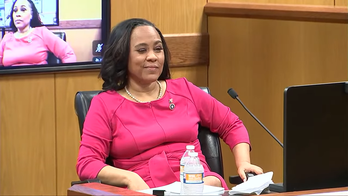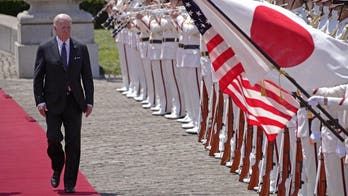"You never know with trade agreements," mused a House Republican aide recently. "You can never take anything for granted."
And such is the case as the House of Representatives embarks on a slate of three trade agreements this week. They're designed to bolster the sale of goods and exchanges of services between the U.S. and Colombia, South Korea and Panama.
Trade pacts and their political volatility date back to the approval of NAFTA, the North American Free Trade Agreement in 1993. At that time, the concept of broadening trade was anathema to many "pro-labor" Democrats. The nation was fresh off a vigorous debate over globalization and the loss of American jobs overseas in the 1992 presidential campaign. Independent presidential contender Ross Perot and Republican presidential candidate Pat Buchanan capitalized on the nation's discord over a stagnant economy. They became champions of those who feared the loss of manufacturing jobs abroad and an exploding U.S. trade deficit, spurred by a prevalence of inexpensive products dumped into the U.S. marketplace. As a result, Buchanan topped the sitting president, George. H.W. Bush in the 1992 New Hampshire primary. Perot garnered nearly 20 percent of the popular vote in the general election, describing the phenomenon of loss of American jobs overseas to "a giant sucking sound."
But the centrist, "new" Democratic President Bill Clinton pulled out all the stops and successfully muscled NAFTA through the House and Senate before he was even through his first year in office.
It would be another 12 years before Congress would again struggle with significant free trade measures. By that point, the geo-political landscape was much different than the one under which Bill Clinton shepherded NAFTA across the finish line.
The U.S. trade deficit with foreign trade partners ballooned further. And a new player arrived on the field: China.
In 2005, the Central American Free Trade Agreement, or CAFTA, was one of the major legislative initiatives undertaken by President George W. Bush. Bush narrowly won re-election the year before. He faced a skeptical House of Representatives, concerned about how a trade accord with Costa Rica, El Salvador, Guatemala, Honduras and Nicaragua could adversely impact workers in some House districts.
By mid-2005, the U.S. viewed China as a global economic threat, especially if the Chinese could beat the U.S. by depositing their goods on Central American shelves first. That's one of the reasons the Bush Administration seized the CAFTA mantle. And it would take every possible cubic centimeter of political capital Mr. Bush had to drag CAFTA to passage.
President Bush paid a rare visit to the Capitol to lobby for the bill. As the vote approached, he dispatched then-Vice President Dick Cheney to appeal to leery lawmakers, many in his own party.
Cheney set up shop just off the House floor in a suite of rooms controlled by Ways and Means Committee Chairman Bill Thomas (R-CA). Meantime, then-U.S. Trade Representative and current Sen. Rob Portman (R-OH) roamed the halls, dialing through his BlackBerry and buttonholing CAFTA opponents. Commerce Secretary Carlos Gutierrez chatted up unsure lawmakers in the Speaker's Lobby, directly behind the dais in the House chamber.
Despite eking out reelection, President Bush faced thin support from his party's faithful. An effort to partially-privatize Social Security had already imploded earlier in the year. A defeat of CAFTA by the president's own party would represent a near unprecedented repudiation of the commander in chief.
House Democrats sensed blood in the water and were in no mood to help an imperiled president. But Mr. Bush faced bigger problems on his own side of the aisle.
In the words of then-Chief Deputy Whip Eric Cantor (R-VA), it was "all hands on deck by the administration." And if the president was to succeed with CAFTA, his team would have to cut side deals with suspect lawmakers and delve into some serious minutiae.
Like socks.
Rep. Robert Aderholt (R-AL) represents Fort Payne, AL, known to many as the "sock capital of the world." Aderholt worked the phone with Charles Cole of Alabama Footwear Inc. to assess what sort of sidebar agreement might be acceptable to stave off import surges of hosiery, triggered by CAFTA. Aderholt shuttled back and forth between offices near the House floor, absorbing proposals from Bush's trade team. Gutierrez assured him there would be no sock import surge and joined Portman in asking the military to only purchase U.S.-made socks. In the end, Aderholt voted yes.
In short, the problems for President Bush on CAFTA centered around two types of GOP lawmakers. First, there were moderate Republicans who represented traditional "blue collar" manufacturing electoral bases opposed to free trade. Then there were lawmakers who came from areas which were home to specific industries which could face peril if Congress ratified CAFTA. The latter could be broken down into two sub-areas: lawmakers from Florida and Louisiana which produced sugar and those from Alabama and North Carolina who were tied to the textile industries.
In the "blue collar" category, Republicans looked to Rep. Steven LaTourette (R-OH) whose district stretched from Cleveland to Lake Erie. Then there was Rep. Shelley Moore Capito (R-WV). Finally, the Republican leadership evaluated figures like Reps. Michael Fitzpatrick (R-PA) and then-Rep. Rob Simmons (R-CT).
In the "products" area, lawmakers like former-Rep. Mark Foley (R-FL) opposed the pact for how it may effect sugar producers in the Sunshine State. Reps. Charles Boustany (R-LA) and then-Rep. (now Gov.) Bobby Jindal (R-LA) had similar concerns.
Bush was successful in bringing Aderholt on board from the "textile" caucus.
But the president had not yet secured the vote of former-Rep. Robin Hayes (R-NC).
Hayes had outright opposed CAFTA from the start. Just a year before the CAFTA vote, Pillowtex, which made towels, sheets and wash cloths and employed most of its 7,500 employees in Hayes' district, shuttered. The "optics" of voting for CAFTA wouldn't look good for Hayes.
"Every time I drive through Kannapolis (NC) and I see those empty plants, I know there is no way I could vote for CAFTA," Hayes said at the time.
Hayes remained a nay on the day of the vote. And that's when then-Speaker Dennis Hastert (R-IL) summoned the North Carolina Republican to his office and asked him to vote yes.
Hayes informed the speaker he couldn't.
"(Hastert) paused for a minute and said ‘I never should have asked you to do that,'" Hayes recalls. But Hastert did ask Hayes to wait until the end of the CAFTA roll call vote before casting his ballot.
Hayes agreed.
Hayes was intrigued by the possibility of a sidebar arrangement which dealt with the dying and finishing of textiles. Textile products could be colored and completed in the CAFTA nations. But the original product had to be woven in the United States.
Just before the vote, Hayes told a reporter he remained a no. But the GOP had to keep what is usually a 15-20 minute vote open for close to an hour to conjure up the necessary yes votes. Hastert assured Hayes that he would score his provision on weaving textiles in the U.S. before sending them south for completion.
True to his word, Hayes held his vote until the end. And just before the GOP closed the vote, the North Carolina Republican voted yes.
The House approved CAFTA 217-215. Had Hayes voted no, the vote would have been 216-216. By rule, tie votes fail in the House and CAFTA would have imploded.
As a result, Hayes secured a written letter on the matter from President Bush. In addition, Hayes said then-Labor Secretary Elaine Chao promised she would bend over backwards to help out-of-work people in Hayes' district.
"I don't think we would have gotten as much help from the federal government had I not pushed the issue," Hayes said.
But Hayes' yea vote wasn't the only essential one to guarantee CAFTA's passage.
Good legislative floor engineers never want a measure to hinge on the vote of just a single lawmaker. When necessary, it's important to have cushion. But it's also crucial to "ice" wavering lawmakers or potential "yeas" until the end of the vote so the public doesn't view that individual as "casting the decisive vote" on an issue.
One such lawmaker was Steven LaTourette. Early on, LaTourette opposed CAFTA. Portman had just left the House in May of that year to become U.S. Trade Representative. And not long before the vote closed, but victory was far from certain, Portman conducted a lengthy pow-wow with his former Buckeye State colleague in the hall outside the House chamber.
LaTourette voted yes just before they closed the vote.
LaTourette later conceded that the vote was his "worst" night ever in the House of Representatives. But he said he would "sleep tonight." LaTourette said even though many in his district had reservations about CAFTA, he could weather the political fallout a lot easier than some other lawmakers.
++++++++++++++++++++++++++++++++++++++++++++++++++++++++++++++
House leaders aren't anticipating as much opposition to the triumvirate of the Panama, South Korea and Colombia free trade deals later this week. Most Republicans are set to vote in favor. However, some conservatives and those aligned with the tea party may vote no. House Minority Whip Steny Hoyer (D-MD) declared last week that he anticipated most Democrats would favor Trade Adjustment Authority (TAA), which provides training for workers who have lost their jobs. But there are a number of no votes to the pacts.
Rep. Michael Michaud (D-ME) is one of the most-ardent opponents of the trade pact trio.
"I'm extremely disappointed in the president," said Michaud. "Ross Perot had it right. You hear a big sucking sound."
Michaud said he's picking up some no votes. Still, this vote doesn't appear to be coming down to the wire like CAFTA.
But, as the House GOP aide said, you can never be too sure about trade agreements and certainly "can never take anything for granted."




